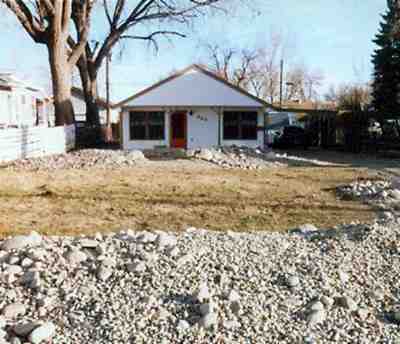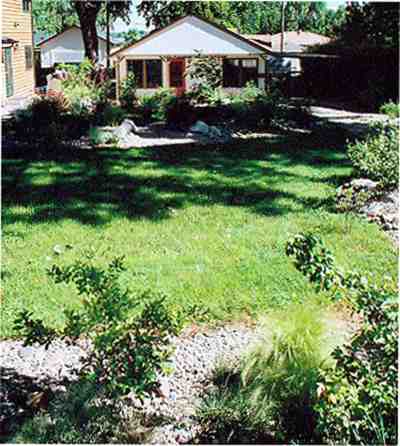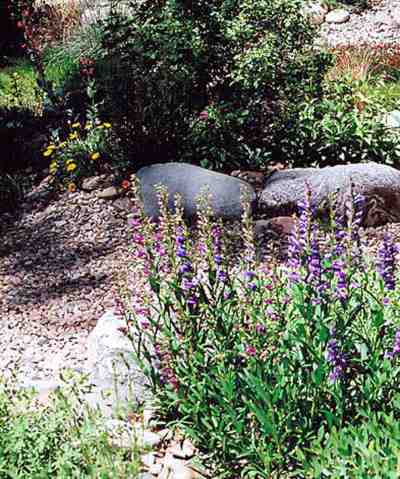Article by Ray Schoch
Water – May 2006 – Colorado Central Magazine
ALL RIGHT CLASS, it’s time to review. Back in May of 2003, you read an article in this very magazine advocating the use of xeriscape, or “water-smart” landscape design.
No peeking, now — who was the author? Where did he live? What were his motivation(s)?
I was afraid of that. Aren’t pop quizzes a pain? Memory is less reliable as we age.
So, a brief review.
I moved to Colorado from suburban St. Louis, where water is not an issue. Ever. When I bought my small house in Loveland, I wanted a yard that was adapted to the climate instead of trying to impose the Midwest on semi-arid Colorado conditions. Prairie grasses, shrubs and wildflowers had seemed exotic to me when I vacationed in the state years before. When I started my project in 2003, they seemed just as beautiful to me, and they still do.

My motivation(s) for experimenting with xeriscape were, as I said in Issue No. 111, threefold. It made sense to use plants that grew here as natives, or were adapted to similar climate conditions. Second, the idea of a short-grass/bunch grass prairie was one that appealed to me on several levels, not least of which was the possibility of not having to mow the lawn. Finally, I felt sure my water bills would be lower.
To no one’s surprise, even my own, the project has not gone entirely according to plan, but the results please me and the deviations from my original plan have not, in the end, proved to be much more than inconveniences in most respects.
Three years ago, I advocated reading and asking questions for people who would like to have “water-smart” landscaping, but don’t know where to begin. That advice still stands, and I still read widely about plants and xeriscape or “water-smart” principles as applied to the Rocky Mountain West. Local book stores are likely to have several titles related to “water-smart” landscape design and construction, and if you’re interested, they’re a worthwhile investment.
I’ve attended several gardening workshops — asking enough questions to make a pest of myself, I’m sure — and in general have done my best to educate myself about what works, what’s practical, and what’s just too darned expensive for someone of modest means. Plant and garden workshops have been plentiful sources of information, as have local nurseries and garden centers.
Garden books and nursery employees stress, sometimes correctly, that soil preparation is very important to “water-smart” landscaping. I say “sometimes correctly” because I think soil preparation goes back to the initial process of thinking about what it is you’re trying to accomplish. If what’s really desired is an oasis of plants from Midwestern, and even Eastern climates, then soil preparation is not only important, it’s essential.
Quite a bit of organic matter must usually be added to native Colorado soils, which have plenty of minerals washed down from the mountains over the eons before we arrived, but very little organic matter because — as archaeologists will attest, the dry climate slows decomposition dramatically.

MY GOAL was something reminiscent of high prairie, using mostly plants native to the Front Range, and especially to the “piedmont” here in Loveland, in the shadow of the Dakota Hogback, but not really in the mountains. As a result, when a local landscape firm built berms in my front yard, I specified “ordinary,” non-amended, topsoil. I wanted to grow Penstemons, for one thing, and most Western varieties of those perennial wildflowers prefer soil that has not been heavily amended.
The yard was just about to be “hardscaped” at the end of the previous article in Issue No. 111. I asked the landscape firm to build three berms, angled slightly so that they were 10 degrees away from being parallel to the street. I wanted berms because my yard was basically flat, and many xeric plants like “well-drained” locations. Planting them in berms is basically the same as planting them in a raised bed, meaning that drainage will be good and the plants will not have to deal with “wet feet.” The task of building the berms was completed in 2 days by a local firm. They did not work for free, and the cost of adding a “vertical element” to the yard was the largest single expense of the project. It also provided some entertainment for neighborhood children as well as myself. Few things are as indulgently interesting as an hour watching other people work.
Everything since then — further hardscaping, many, many hours spent planting, mulching, weeding, and so on — has been done by yours truly, including hauling rocks big and small in quantities, sizes and weights that I’m certain were never envisioned by the designers of my 11-year-old automobile — nor by the orthopedic surgeon who worked on my spine a generation ago.
MANY A COLORADO urban/suburban landscape relies on an irrigation system of some sort, and this is as good a point as any to bring them up. Most of my Loveland neighbors have in-ground irrigation systems, and most of those systems are controlled by timing mechanisms of one kind or another. I decided before the first berm was even designed that I did not want such a system.
My bias is that, even though they can be made to be quite water-efficient through the use of technology in the form of moisture sensors and sophisticated timers, underground systems cost a lot of money, and homeowners too often apply a “set it and forget it” frame of mind to applying water to their landscape, whatever it might be. I wanted to avoid the expense of an underground system for financial reasons — I live on a relatively fixed income, significantly below the median for this part of Colorado, and the cost of an underground system seemed prohibitive — and I also wanted to be the one to decide when and how to water the landscape I was creating. The “set it and forget it” mind set is one that seems to encourage, or at least permit, wasting water by overwatering. Deciding to avoid an underground irrigation system made hardscaping, in some ways, the easiest and least time-consuming part of the landscape process, much as framing a house generally takes less time than finishing it.<
Once the berms had been constructed, there were many, many decisions to make regarding just what plants to buy (and how to budget in order to do so), and where to put them, since a mistake in location could ultimately prove stressful, or even fatal to the plant. Complicating these decisions was the overall reality that most drought-tolerant native species have evolved to do well in a genuine prairie environment, meaning, among other things, one without trees. They like to spend their days in full sunlight.
I wasn’t much interested in what some like to think of as the stereotype of the “water-smart” or xeric landscape, which is rocks and cactus. Instead of hard-edged rocks, for example, I chose to use streambed rock, which has been smoothed and rounded over many, many centuries. I decided that, while I probably could plant cactus, and even though some cactus species have quite impressive and beautiful flowers, there was too much shade in the yard for them to really thrive, and more importantly, cactus are…. well…. not exactly people-friendly. I was more interested in creating a landscape that was interesting to look at through the entire year, and that, during the growing season, would have something in bloom just about all the time. I was also interested in creating a landscape that was friendly to birds (especially hummingbirds) and bees.
A FRONT YARD bordered on both east and west sides by 60-year-old cottonwoods does not qualify as being in “full sunlight” by any definition that makes sense. The front of the house tends to be in the sun most of the day, while the 20 feet or so of the yard closest to the street gets morning sun only. The sizable chunk of front yard between the sidewalk and the front porch is in light shade much of the day. I tried to choose plants accordingly, putting the sun-lovers either at the front edge of the yard, in the berm closest to the street, or in the berm closest to the house.

Much of the lawn remaining in the yard after the berms were constructed was left as it was, since that portion of the yard was in shade through much of the day, which meant it didn’t require as much watering as it would have if it were in full sunlight.
For budgetary reasons, I tended to buy one-gallon, or #1-sized plants instead of 5-gallon or #5-sized plants. Starting small was a little frustrating at first, but the plants have caught up quickly, for the most part, and plantings are now starting to fill in as intended. In 2003, the first season after the berms were constructed, I spent several hundred dollars on plants. The next season, 2004, I spent even more — something over $1,000. Last year, with most of the planting done, I spent perhaps $300, and most of that was for plants to put into a small additional berm I’d constructed myself. After the first season in 2003, I paid attention to which plants were “happy,” and had done well where I’d put them, which had been “unhappy,” or performed poorly, and what seemed to be the reasons for both. I then tried to incorporate what I’d learned into the list of plants to buy (or not to buy) for the next season.
SOMETIMES, OF COURSE, things don’t go according to plan. The neighbors to the west, for example, built a sizable addition onto the back of their house, beginning in 2004. Constructing that addition led them to take down one of the Cottonwoods that marked the boundary between our respective yards. Removing the Cottonwood provided a yin- and-yang experience in itself. That particular tree had provided afternoon shade for my non-air-conditioned house. Accordingly, I felt it necessary to add 10 inches of additional insulation above my living space in a largely-successful effort to avoid the expense of having to install central air-conditioning. On the other hand, removing that tree provided considerably more afternoon sun to portions of the yard near the house that had been in the shade before, and the plants noticed the change right away. Most of them perked up noticeably, and I took note of that in purchasing plants last year.
Three years after it began, the project is more-or-less complete. The berms have settled somewhat, and if I were doing it again I’d insist on another 6 inches or even a foot more in height for the berms to compensate for that settling. I’ve lost about a dozen plants out of the 200 or so I’ve put in the ground, so even though my black thumb remains intact for indoor plants, I’ve proved that even an inept gardener, when working with native plants and the help of local garden and nursery personnel, can be successful. More important, from my perspective, is that I like the result.
Beginning with Crocus and Miniature Iris in March, there is something in flower pretty much every month until the first frost. Other bulbs bloom in April, and “May Night” meadow sage is in bloom by…. well…. May. Native Chokecherries and Serviceberries flower in April and May as well, and June is definitely Penstemon month. I have several varieties, and they’ve bloomed reliably. So have the Columbines, which have proved adaptable in terms of both water and sunlight. By late summer, Blanket Flower and Campion are showing off, and the Hummingbirds are especially fond of the “California Fuscia,” which blooms flame-red beginning in late August. They last until the frost, and in our brief fall season, the Chokecherries and a pair of Bigtooth Maples provide plenty of color. The ornamental grasses, Little Bluestem, Western Wheatgrass and others, provide interest through the snowy winter, as do the rocks.
Finally, there’s the matter of water. My highest month for water use in Loveland during my first summer here, before any xeriscaping was done, was July, when I used 11,000 gallons. Last year, my highest water use was in August, when I used 4,000 gallons. “Average” use for single-family, detached households in Loveland is 25,000 gallons per month during the summer months of June, July and August. I serve on two City committees that are examining landscape standards and water usage.
NOT ONLY WILL THE PRICE of irrigation taps for new development double, and in some cases more than double, this year with the adoption by City Council of new rates for new taps, water bills for “regular” customers and HOAs will also increase. Loveland just finished building a new and much larger reservoir, which will fill this year, and another one is being planned. To pay for that planned increase in water storage, water rates in the City will increase by 1 percent a year each year for the next 20 years, or whatever it takes to generate $36 million to build that reservoir. That, in itself, may provide many of my neighbors with an incentive to look more closely at their domestic landscapes.
If we have not done so already — and there are people in Colorado who know far more about water than I — we will soon reach a point where water is no longer a resource to be developed, but will be a “fully developed” resource that we must learn to use and manage much more efficiently than is now generally the case. If we can create beauty in the process, I see little reason to continue to try to recreate Indiana or Missouri in an area where the climate and soil obviously do not lend themselves to the creation of that sort of artificial environment.
Ray Schoch chairs the Loveland Planning Commission, and travels to Central Colorado frequently.

